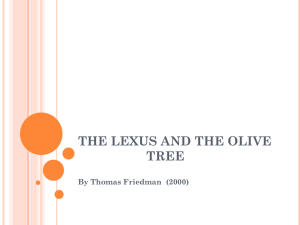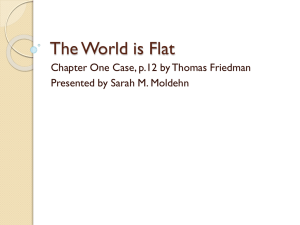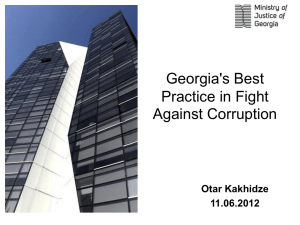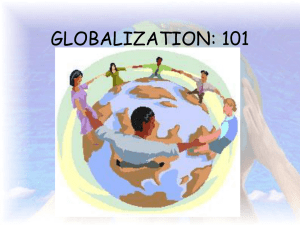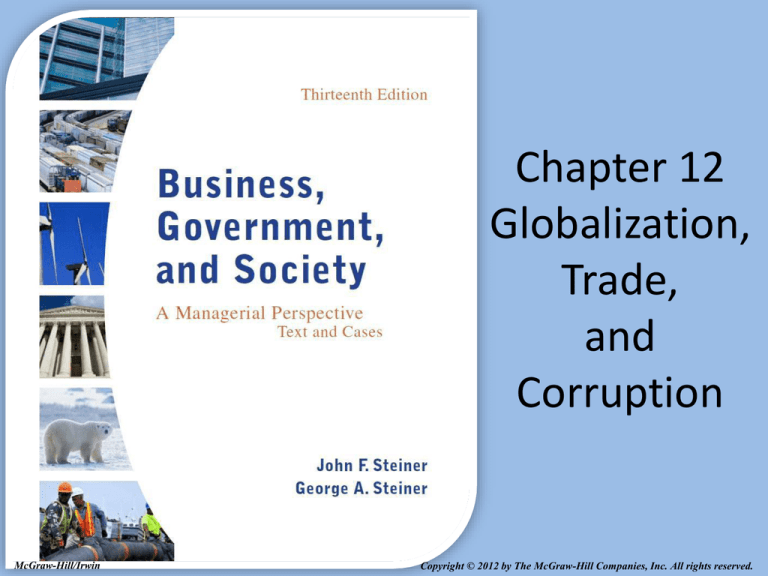
Chapter 12
Globalization,
Trade,
and
Corruption
McGraw-Hill/Irwin
Copyright © 2012 by The McGraw-Hill Companies, Inc. All rights reserved.
McDonald’s Corporation Opening Case
o More than half of McDonald’s restaurants are outside
of the U.S., accounting for 61% of company revenues
o As a prominent global brand McDonald’s symbolizes
perceived evils of globalization
o In developing nations, the arrival of a McDonald’s is
regarded as a sign of modernization
12-2
McDonald’s Corporation Opening Case
o McDonald’s does transfer cultural values and
practices
o Most of McDonald’s international restaurants are
franchises, run as local businesses
o The entrepreneurs who run these businesses adapt
them to local custom
12-3
Globalization?
o Globalization: Growth in networks of economic,
political, social, military, scientific, or environmental
interdependence to span worldwide distances
12-4
Figure 12.1 - Main Forces in Globalization
12-5
Figure 12.2 - The KOF Index of Globalization
and Subindexes: 1970–2010
12-6
Pros of Globalization
o Has lifted millions of people out of poverty
o Consumer benefits of more variety, lower costs, and
higher quality of products
o Improved working conditions for millions of workers
o Human rights have improved
12-7
Ascent and Inertia
o Great benefit of globalization is human progress
o Since 1970, 155 countries with about 95 percent of
world population have experienced rising incomes
o Global progress is not uniform
12-8
Table 12.1 - The Top 10 Most and Least
Globalized Countries
12-9
Trade
o The mainspring of globalization is trade
o The total value of merchandise exports rose from $58
billion in 1950 to a high of $16.1 trillion in 2008
12-10
The Rise and Fall of Trade
o Before 1800, growth of the world economy was slow
and limited
o The richest European nations, the dominant traders of
the time, ran their economies according to the theory
of mercantilism
o Mercantilism: A policy of increasing national power
by managing the economy to create a trade surplus
o Exports were promoted, imports restricted
12-11
The Rise and Fall of Trade
o The great run of free trade ended with World War I,
which inflamed global markets with national conflicts
o In the United States an isolationist, Republican
Congress passed the remarkably unwise SmootHawley Tariff Act in 1930
o Tariff: A tax or duty charged by a government on
goods moved across a border
12-12
The Rise and Fall of Trade
o In the downward spiral of retaliation and bitter
national rivalries some governments moved in the
direction of autarky
o Autarky: A policy of national self sufficiency and
economic independence
12-13
A New Postwar Order
o After the war, representatives of the victorious
nations met in the small town of Bretton Woods, New
Hampshire, to forge an agreement
o They created three institutions that began their work
in 1947
o World Bank
o International Monetary Fund
o International Trade Organization
12-14
A New Postwar Order
o The rules were built around two key principles
o Most favored-nation
o National treatment
12-15
Figure 12.3 - A History of Multilateral
Trade Rounds
12-16
Regional Trade Agreements
o The European Union (EU)
o The North American Free Trade Agreement (NAFTA)
o The Association of Southeast Asian Nations Free
Trade Area (AFTA)
o The Southern Common Market (Mercosur)
12-17
Why Free Trade?
o Free trade: The flow of goods and services across
borders unhindered by government imposed
restrictions such as taxes, tariffs, quotas, and rules
o Competitive advantage of nations: The theory that
having a cluster of similar producers gives a nation
special advantage over other countries
12-18
Why Free Trade?
o Law of comparative advantage: Efficiency and the
general economic welfare are optimized when each
country produces that for which it enjoys a cost
advantage
o It is argued that free trade will stimulate competition,
reward individual initiative, increase productivity, and
improve national well-being
12-19
Why Protectionism?
o Protectionism: The use of trade barriers to shield
domestic industries from foreign competitors
o It exists in the trade histories of all nations for four
basic reasons:
o Barriers help to lower unhealthy trade deficits
o Some governments use an industrial policy to promote
the growth of technologies, companies, or industry
sectors
12-20
Why Protectionism?
o Foreign countries sometimes use unfair trade tactics
o Tariffs are important sources of revenue for some
governments, particularly in low-income countries
12-21
Free Trader Responses to Protectionists
o Free traders advance many arguments against
protectionism
o One main argument is the logic of overall benefit
o A major cause of the rise in world trade is the
widespread reduction in defensive barriers
12-22
U.S. Deviation from Free Trade Policy
o Despite strong free trade rhetoric and the steady
lowering of tariff and other trade barriers, the United
States protects industries from foreign competition
o The Federal Buy American Act
o The Merchant Marine Act
o The Passenger Vessel Services Act
o U.S. tariffs have declined significantly in recent
years, but there are many exceptions
12-23
Tariff Barriers in Other Countries
o China still imposes substantial barriers on imports
such as watches, automobiles, steel, textiles, and
many food products
o Japanese restricts U.S. imports of meat, poultry,
vegetables, and fruit products
o Various restrictions among European Union countries
are applied to genetically engineered commodities
o Taiwan restricts imports of rice
12-24
Tariff Barriers in Other Countries
o Korea imposes high duties maintains a broad range of
trade restrictions and nontariff barriers on agricultural
and fishery products
o Brazil still retains high tariffs on technology products
o Mexico still retains substantial trade restrictions on
products such as meat, poultry, vegetables, and fruit
12-25
Corruption
o Corruption: The debasement of integrity for money,
position, privilege, or other self-benefit
12-26
Figure 12.4 - The Corruption Spectrum
12-27
Table 12.2 - The Demand Side of
Corruption
12-28
Table 12.3 - The Supply Side of Corruption
12-29
The Fight Against Corruption
o The Foreign Corrupt Practices Act (FCPA) makes it
both a civil and a criminal offense to bribe an official
of a foreign government or ministry, or a member of a
foreign political party or candidate for office
o The FCPA is a powerful law with global reach
12-30
The Fight Against Corruption
o Basic actions multinational corporations can and do
take to fight corruption
o Set up an ethics and compliance program
o Establish appropriate policies
o Publicize the anti-corruption program to establish a
reputation for honesty
o Train employees
o Assure confidential, rapid reporting of solicitations to
management
12-31
The Fight Against Corruption
o Enforce penalties against violators
o Use due diligence when hiring agents, consultants, and
intermediaries or when taking on new business
partners
o Work with international organizations, industry
groups, and other companies to share information
about experiences with corruption
12-32
Concluding Observations
o The integration of humanity is greater now, despite
some resistance, because of new technologies
o Economic globalization has led the way
o One major impediment to this growth is corruption
o There is widespread and effective effort by
governments to control it
12-33






